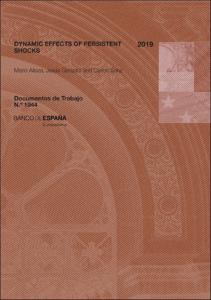Dynamic effects of persistent shocks
Authors
Issue Date
23-Dec-2019
Physical description
57 p.
Abstract
We show that several shocks identifi ed without restrictions from a model, and frequently used in the empirical literature, display some persistence. We demonstrate that the two leading methods to recover impulse responses to shocks (moving average representations and local projections) treat persistence differently, hence identifying different objects. In particular, standard local projections identify responses that include an effect due to the persistence of the shock, while moving average representations implicitly account for it. We propose methods to re-establish the equivalence between local projections and moving average representations. In particular, the inclusion of leads of the shock in local projections allows to control for its persistence and renders the resulting responses equivalent to those associated to counterfactual non-serially correlated shocks. We apply this method to well-known empirical work on fi scal and monetary policy and fi nd that accounting for persistence has a sizable impact on the estimates of dynamic effects.
En este documento mostramos que varios shocks identifi cados sin restricciones de un modelo, y usados frecuentemente en la literatura empírica, son persistentes. Demostramos que los dos principales métodos para recuperar respuestas a impulsos de shocks (representaciones de media móvil y proyecciones locales) tratan la persistencia de distinta manera y, por tanto, identifi can objetos diferentes. En particular, las proyecciones locales estándar identifi can respuestas que incluyen un efecto debido a la persistencia del shock, mientras que las representaciones de media móvil implícitamente controlan por la persistencia. Proponemos métodos para restablecer la equivalencia entre proyecciones locales y representaciones de media móvil. En particular, la inclusión de adelantos del shock en las proyecciones locales permite controlar por su persistencia y hace que las respuestas resultantes sean equivalentes a las asociadas a shocks contrafactuales no autocorrelacionados. Aplicamos este método a trabajos empíricos sobre política fiscal y monetaria y encontramos que controlar por la persistencia tiene un impacto considerable sobre las estimaciones de efectos dinámicos.
En este documento mostramos que varios shocks identifi cados sin restricciones de un modelo, y usados frecuentemente en la literatura empírica, son persistentes. Demostramos que los dos principales métodos para recuperar respuestas a impulsos de shocks (representaciones de media móvil y proyecciones locales) tratan la persistencia de distinta manera y, por tanto, identifi can objetos diferentes. En particular, las proyecciones locales estándar identifi can respuestas que incluyen un efecto debido a la persistencia del shock, mientras que las representaciones de media móvil implícitamente controlan por la persistencia. Proponemos métodos para restablecer la equivalencia entre proyecciones locales y representaciones de media móvil. En particular, la inclusión de adelantos del shock en las proyecciones locales permite controlar por su persistencia y hace que las respuestas resultantes sean equivalentes a las asociadas a shocks contrafactuales no autocorrelacionados. Aplicamos este método a trabajos empíricos sobre política fiscal y monetaria y encontramos que controlar por la persistencia tiene un impacto considerable sobre las estimaciones de efectos dinámicos.
Publish on
Documentos de Trabajo / Banco de España, 1944
Subjects
Impulse response function; Local projection; Shock; Fiscal policy; Monetary policy; Función de respuesta a un impulso; Proyecciones locales; Shock; Política fiscal; Política monetaria.; Fluctuaciones y ciclos económicos; Política monetaria; Política fiscal
Appears in Collections:












